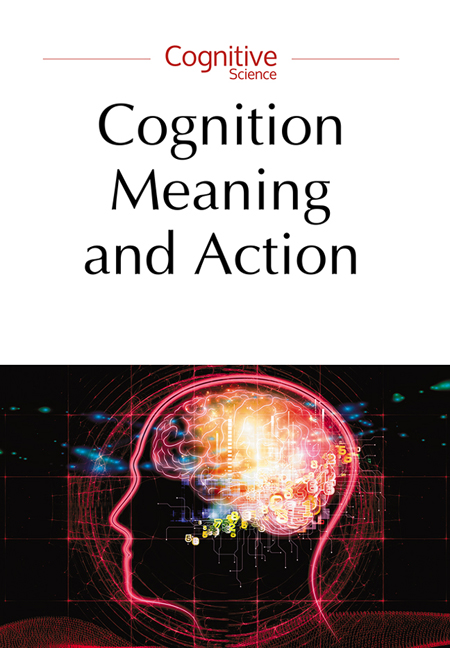Book contents
- Frontmatter
- Contents
- The crossroads of cognitive science
- Cognitive science: From computers to ant hills as models of human thought
- Two procedures expanding a linguistic competence
- Neurobiological basis for emergence of notions
- Similarity as distance: Three models for scientific conceptual knowledge
- The Approximate Numbers System and the treatment of vagueness in conceptual spaces
- Communication, cognition, and technology
- To tell and to show: The interplay of language and visualizations in communication
- Semiotics, signaling games and meaning
- Out of the box thinking
- The everyday of decision-making
- Short- and long-term social interactions from the game theoretical perspective: A cognitive approach
- Notes about Authors
Semiotics, signaling games and meaning
Published online by Cambridge University Press: 10 January 2018
- Frontmatter
- Contents
- The crossroads of cognitive science
- Cognitive science: From computers to ant hills as models of human thought
- Two procedures expanding a linguistic competence
- Neurobiological basis for emergence of notions
- Similarity as distance: Three models for scientific conceptual knowledge
- The Approximate Numbers System and the treatment of vagueness in conceptual spaces
- Communication, cognition, and technology
- To tell and to show: The interplay of language and visualizations in communication
- Semiotics, signaling games and meaning
- Out of the box thinking
- The everyday of decision-making
- Short- and long-term social interactions from the game theoretical perspective: A cognitive approach
- Notes about Authors
Summary
Introduction
The 20th-century discussion on meaning was dominated by two distinct schools of thought – by that of naturalistic semantics and by that of structural semiotics. Although the two have traditionally been viewed as conflicting approaches, the main aim of this paper is to show that they can be seen as complementary to one another. In order to achieve this objective, we will examine the advantages and drawbacks of both approaches (represented, respectively, by Eco's semiotics and Skyrms’ game-theoretical semantics). The results obtained this way provide a basis for further development of hybrid system by combining features of structural and naturalistic models.
Structural semiotics. Between signalization and signification
The distinctive feature of structural semiotics is a strict separation of two independent semiotic systems: signalization and signification. At the same time, in accordance with the basic premise of structural semiotics, it is only through both of these autonomic systems that a proper communication process can work successfully. Considered in itself, signalization is simply “the passage of a signal (not necessarily a sign) from a source (through a transmitter, along a channel) to a destination” (Eco, 1976: 8). The signals used for this process derive from a special kind of semiotic system called s-code, resulting from the division of some natural or artificial continuum. An essential feature of s-code is that all of the primary system components are isolated arbitrarily (ibid.: 77). Nevertheless, when selected, they are to form a well-organized, independent system, in which the identity of each unit is completely determined by reference to others, and hence specified by its position in the whole (ibid.: 38). The system established in this way is an internally structured matrix with certain combinatorial properties (determined by a set of combinatorial rules). As a result, it possesses also some informational potential. It is precisely (mathematically) defined by the intrinsic properties of the system (arrangement of elements and combinatorial rules), determining the amount of information possible to transmit. So configured, the system can operate autonomously – without any semantic reference: “s-codes are systems or ‘structures’ that can also subsist independently of any sort of significant or communicative purpose” (ibid.).
- Type
- Chapter
- Information
- Cognition, Meaning and ActionLodz-Lund Studies in Cognitive Science, pp. 137 - 152Publisher: Jagiellonian University PressPrint publication year: 2015



